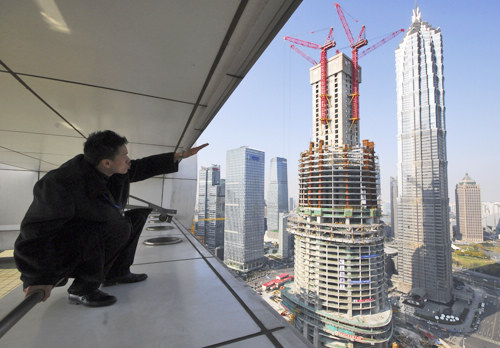|
 |
|
RACING TO THE SKY: A man points to the Shanghai Tower (front) under construction alongside the Jin Mao Tower and Shanghai World Financial Center in Shanghai on January 17 (NIU YIXIN) |
"China does indeed need tall buildings in the process of urbanization because the country has a large population. Skyscrapers could, to a degree, help reduce land consumption," Wang said. "However, given the high costs of building skyscrapers and maintaining them as well as the environmental problems they cause, urban planning authorities should be cautious in approving skyscraper projects."
The 421-meter-tall Jin Mao Tower, Shanghai's second tallest building, cost 20,000 yuan ($3,163) per square meter to build in 1994-99. However, the building costs more than 1 million yuan ($157,480) per day to maintain according to the Shanghai-based news portal Eastday.com.
The skyscraper boom in China has also raised concerns over the safety of the buildings.
Li Zhengnong, a professor at the Civil Engineering School of Hunan University, said that high-rise buildings are susceptible to safety problems, since disasters in such buildings, especially fires, are difficult to cope with.
However, skyscraper developers in China seldom pay attention to such issues. For example, regulations stipulate that there should be an emergency fire refuge for every 14 floors of a building, but many skyscrapers in China do not meet that standard.
According to the Fire Service of the Beijing Municipal Public Security Bureau, safety concerns remain over the firefighting facilities included in the designs of the China Zun in Beijing.
Ma Jianmin, director of the service's building plan review section, said, "Although the most advanced fire lifts will be installed in the skyscraper, they won't be of any use once a fire paralyzes the power system."
The building's top floor will function as a sightseeing platform and café, providing visitors with a panoramic view of the CBD, according to the developer CITIC Group.
This, however, raises more safety concerns. It is stipulated in law that a parking apron as well as a refuge story should be incorporated into such tall buildings. The China Zun currently fails to meet these design standards.
"It will take two more years to improve the firefighting facilities in the building," said Wu Chen, one of the main designers of the China Zun.
Another major problem associated with skyscrapers is land subsidence. According to a report from the national broadcaster CCTV in February, signs of land subsidence have been reported in more than 50 cities across China. Excessive exploitation of underground water is believed the main cause for the problem, but an increasing density of high-rise buildings in urban areas has also been blamed for causing land in cities to sink.
Early in January, the downtown Hailun Road Station of the Shanghai Metro Line 4 was closed for emergency reinforcement after the occurrence of "uneven subsidence." Pit digging work for new buildings nearby caused the subsidence, according to the Shanghai Daily.
Usually, "uneven subsidence" takes place where there is construction work, which adds considerable weight to the base and leads to cracks and distortion.
To tackle the problem in a more systematic way, the State Council, China's cabinet, approved the Land Subsidence Prevention Program on February 20, demanding local governments to improve their management systems to ensure building stability and come up with more effective measures to prevent subsidence.
For the construction of skyscrapers, meticulous preparation is now required to ensure safer designs, and it is important to take possible earth slippage issues into consideration before construction in order to prevent problems caused by subsidence.
Email us at: yinpumin@bjreview.com | 